cam.gcodepath#
BlenderCAM ‘gcodepath.py’ © 2012 Vilem Novak
Generate and Export G-Code based on scene, machine, chain, operation and path settings.
Functions#
|
Determine if the angle between two vectors is within a specified |
|
Exports G-code using the Heeks NC Adopted Library. |
|
Calculate the path for a given operation in a specified context. |
Check if object properties have changed to determine if image updates |
|
Check and adjust the memory limit for an object. |
|
|
Generate a machining path based on the specified operation strategy. |
|
Generate a path for a specified axis based on the given operation. |
Module Contents#
- pointonline(a, b, c, tolerence)[source]#
Determine if the angle between two vectors is within a specified tolerance.
This function checks if the angle formed by two vectors, defined by points b and c relative to point a, is less than or equal to a given tolerance. It converts the points into vectors, calculates the dot product, and then computes the angle between them using the arccosine function. If the angle exceeds the specified tolerance, the function returns False; otherwise, it returns True.
- Parameters:
a (numpy.ndarray) – The origin point as a vector.
b (numpy.ndarray) – The first point as a vector.
c (numpy.ndarray) – The second point as a vector.
tolerence (float) – The maximum allowable angle (in degrees) between the vectors.
- Returns:
- True if the angle between vectors b and c is within the specified
tolerance, False otherwise.
- Return type:
bool
- exportGcodePath(filename, vertslist, operations)[source]#
Exports G-code using the Heeks NC Adopted Library.
This function generates G-code from a list of vertices and operations specified by the user. It handles various post-processor settings based on the machine configuration and can split the output into multiple files if the total number of operations exceeds a specified limit. The G-code is tailored for different machine types and includes options for tool changes, spindle control, and various movement commands.
- Parameters:
filename (str) – The name of the file to which the G-code will be exported.
vertslist (list) – A list of mesh objects containing vertex data.
operations (list) – A list of operations to be performed, each containing specific parameters for G-code generation.
- Returns:
This function does not return a value; it writes the G-code to a file.
- Return type:
None
- async getPath(context, operation)[source]#
Calculate the path for a given operation in a specified context.
This function performs various calculations to determine the path based on the operation’s parameters and context. It checks for changes in the operation’s data and updates relevant tags accordingly. Depending on the number of machine axes specified in the operation, it calls different functions to handle 3-axis, 4-axis, or 5-axis operations. Additionally, if automatic export is enabled, it exports the generated G-code path.
- Parameters:
context – The context in which the operation is being performed.
operation – An object representing the operation with various attributes such as machine_axes, strategy, and auto_export.
- getChangeData(o)[source]#
Check if object properties have changed to determine if image updates are needed.
This function inspects the properties of objects specified by the input parameter to see if any changes have occurred. It concatenates the location, rotation, and dimensions of the relevant objects into a single string, which can be used to determine if an image update is necessary based on changes in the object’s state.
- Parameters:
o (object) – An object containing properties that specify the geometry source and relevant object or collection names.
- Returns:
- A string representation of the location, rotation, and dimensions of
the specified objects.
- Return type:
str
- checkMemoryLimit(o)[source]#
Check and adjust the memory limit for an object.
This function calculates the resolution of an object based on its dimensions and the specified pixel size. If the calculated resolution exceeds the defined memory limit, it adjusts the pixel size accordingly to reduce the resolution. A warning message is appended to the object’s info if the pixel size is modified.
- Parameters:
o (object) – An object containing properties such as max, min, optimisation, and info.
- Returns:
- This function modifies the object’s properties in place and does not
return a value.
- Return type:
None
- async getPath3axis(context, operation)[source]#
Generate a machining path based on the specified operation strategy.
This function evaluates the provided operation’s strategy and generates the corresponding machining path. It supports various strategies such as ‘CUTOUT’, ‘CURVE’, ‘PROJECTED_CURVE’, ‘POCKET’, and others. Depending on the strategy, it performs specific calculations and manipulations on the input data to create a path that can be used for machining operations. The function handles different strategies by calling appropriate methods from the strategy module and processes the path samples accordingly. It also manages the generation of chunks, which represent segments of the machining path, and applies any necessary transformations based on the operation’s parameters.
- Parameters:
context (bpy.context) – The Blender context containing scene information.
operation (Operation) – An object representing the machining operation, which includes strategy and other relevant parameters.
- Returns:
This function does not return a value but modifies the state of the operation and context directly.
- Return type:
None
- async getPath4axis(context, operation)[source]#
Generate a path for a specified axis based on the given operation.
This function retrieves the bounds of the operation and checks the strategy associated with the axis. If the strategy is one of the specified types (‘PARALLELR’, ‘PARALLEL’, ‘HELIX’, ‘CROSS’), it generates path samples and processes them into chunks for meshing. The function utilizes various helper functions to achieve this, including obtaining layers and sampling chunks.
- Parameters:
context – The context in which the operation is executed.
operation – An object that contains the strategy and other necessary parameters for generating the path.
- Returns:
- This function does not return a value but modifies
the state of the operation by processing chunks for meshing.
- Return type:
None
